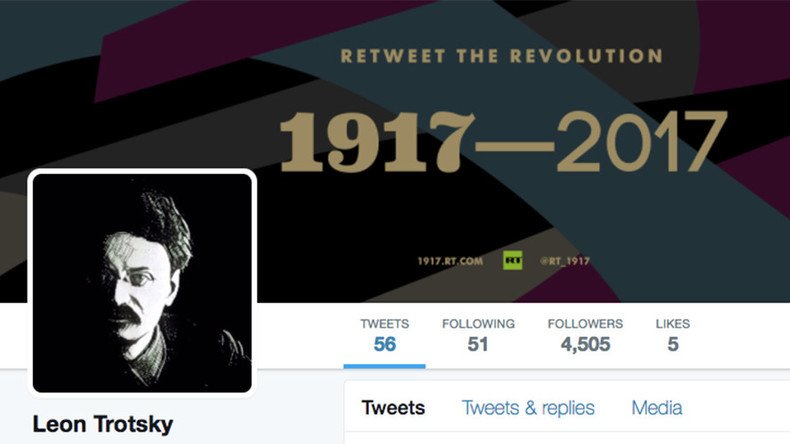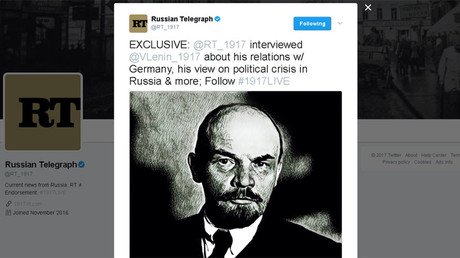#1917LIVE: Leon Trotsky urges world’s proletariat to unite against bourgeoisie in Twitter Q&A

Leon Trotsky is a Marxist reformer destined to become a key figure in Vladimir Lenin’s circle. Although initially a Menshevik, his return from exile and reunion with the Bolshevik leader will cement his role as a key figure of the Russian Revolution.
The Russian Telegraph (RT) is a fictional media outlet, part of the #1917LIVE project, which relives the events of the Russian Revolution through the eyes of its main actors and witnesses. The newspaper recently managed to get an interview with Vladimir Lenin, following his timely return to Russia.
A conversation with Trotsky runs along similar lines, and follows his May 17 return to Petrograd, after years of exile. Like Lenin, Trotsky is intent on formulating a program of asset nationalization, the transfer of power to the Soviets, and uniting the world’s proletarians against their bourgeois governments.
As of May 1917, we see the Soviets gain an upper hand over the Provisional Government, which makes the crucial mistake of not listening to a country that no longer wants any part in the world war Russia is fighting against the formidable German Empire. It is high time for Lenin and Trotsky to come together under a unified banner and further exploit this public backlash as the time of the October Revolution draws nearer and old differences are set aside.
The Bolshevik leader himself will later attest to Trotsky’s importance and colossal potential as an ally and influencer of the masses.
Like Lenin, in his mission to truly internationalize the struggle of the proletariat, Trotsky has the uncanny ability to instil revolutionary fervor in those around him. He shares one particular memory about this.
@RT_1917 Yes, I met a lot of German proletarian POWs. They told me what it’s like to be virtual slave of @Kaiser_1917. They're all fed up! #1917LIVE
— Leon Trotsky (@LeoTrotsky_1917) May 18, 2017
@RT_1917@Kaiser_1917 When we were leaving camp German sailors were shouting ‘To hell with Kaiser & bourgeoisie – long live intl unity of proletariat’✌️ #1917LIVE
— Leon Trotsky (@LeoTrotsky_1917) May 18, 2017
Trotsky also shares the Bolshevik leader’s skepticism that compromising with other political forces in Russia would bring the country out of a political rut.
@RT_1917 First of all, socialists should never make deals & form coalitions with imperialists’ stooges aka @ProvGovt_1917#1917LIVE 1/2
— Leon Trotsky (@LeoTrotsky_1917) May 18, 2017
He is very distrustful of War Minister Alexander Kerensky’s proposal to form a Coalition Government comprised of representatives hailing from different parties.
@RT_1917@ProvGovt_1917 Only if we forget 3 principles: Never trust bourgeoisie; always control your party leaders; trust your own revolutionary drive! #1917LIVEpic.twitter.com/50xhT8FTI1
— Leon Trotsky (@LeoTrotsky_1917) May 18, 2017
Nor does Trotsky believe Kerensky’s idea would solve the problem of the so-called Dual Rule – a period that befell the country as the pro-worker Soviets entered into a power struggle with the bourgeois-oriented Provisional Government in the period after the monarchy was toppled by the February Revolution.
@RT_1917@ProvGovt_1917@PetroSoviet1917 So I'm 100% sure that nothing will change, this diarchy problem will simply live on in a new cabinet #1917LIVE
— Leon Trotsky (@LeoTrotsky_1917) May 18, 2017
Upon his return to Russia, Trotsky immediately sides with the general political ideas of Lenin, but it is later, when Lenin’s followers make further gains and secure an upper hand at the Petrograd Soviet, that Trotsky is really able to get to work as its chairman and a full-fledged member of the Bolshevik party. Together, they try again to overthrow the government of Kerensky in what will become known as the October Revolution.
@RT_1917 No! None of our key goals accomplished. We’re entering age of working class rising up to fight dominant class. Join #Revolution! #1917LIVEpic.twitter.com/dvb4jrj8vQ
— Leon Trotsky (@LeoTrotsky_1917) May 18, 2017













